
MUSCLE SENSOR (EMG)
 |
TECHNOLOGY:
MUSCLE SENSOR (EMG) |
|
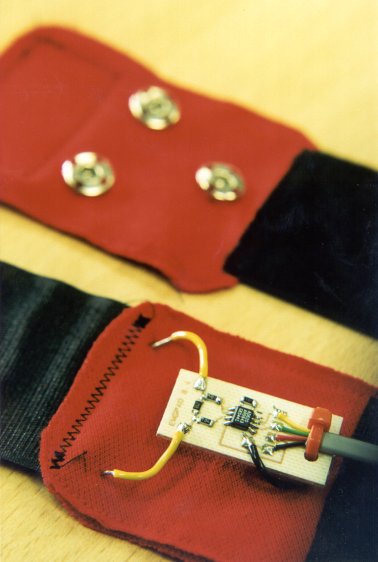
Final design of the Muscle Sensor
wearable
(shows close-up of the worn strap and electronics)
The electromyogram (EMG) sensor detects electrical activity from a muscle using conductive pads placed on the skin. Every time the muscle is activated, individual fibres within it receive electrical impulses, causing them to contract. The firing pattern is random, such that while some fibres are active, others are resting. The stronger the contraction, the more fibres are working at a time and the greater the electrical activity. The muscle sensor reads the sum total of activity, which is effectively a noise signal because it is composed of many random impulses. The example below is a sound recording of a fist being clenched and released and is similar to the noise of wind.
Sound recording (WAV format) of a fist being clenched (8 short pulses followed by 1 long contraction)
The muscle sensor contains signal processing hardware that converts this noisy signal into a voltage level, such that the level is related to the amount of effort being used to activate the muscle. Trials have been conducted in Special Needs schools and mainstream schools in the UK and Sweden. Below are images and RealPlayer* video footage of the sensor in use in the Special Needs environment.
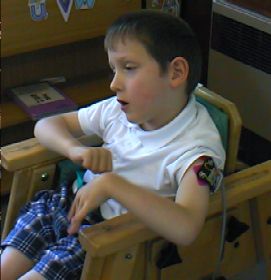
L is pictured at 5 years old, during his first session with (an earlier prototype of) the muscle sensor. Prior to his introduction to Sound Therapy, L seemed to lack the motivation to exercise his limbs and trunk. He was reluctant to stretch and would not use his left arm. He was receiving physiotherapy, but he would sometimes become distressed during these sessions, complaining of discomfort and tiredness, and he needed much encouragement in order to complete his exercises. Even in his first session, wearing the muscle sensor on his left arm, he began to use this arm, suggesting that the presence of the sensor and the sound feedback were providing incentives to movement.
He has responded very well to the CARESS researchers and seemed to thoroughly enjoy the sessions, which have continued for twelve months within this project. His self esteem appears to have been boosted by the 'special skills' he developed in the sessions. Within one month of beginning sessions, he had progressed to controlling two muscle sensors (one on each arm, with different instruments) and a SoundBeam distance sensor (which he controlled with head movements). In these sessions, he controlled his movements very well, indicating that he was aware that his actions were controlling the sound. In one session, he clapped his hands (a new action) to activate the muscle sensors.
Since beginning this Sound Therapy work, he has begun to transfer his use of his left arm outside of these sessions. He has been observed using his left arm and hand voluntarily when engaged in other activities (where previously all activity was with the right hand).
Video segment of one of the early Sound Therapy sessions using the muscle sensor:
High resolution RealPlayer video (670Kb)
Medium resolution RealPlayer video (205Kb)
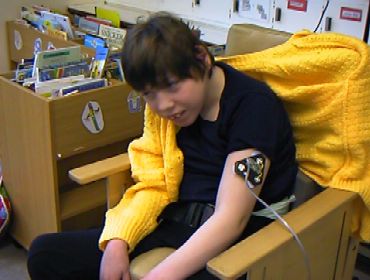
M was 14 years old at the time of this photograph (again with one of the earlier muscle sensor prototypes). She had been having Sound Therapy sessions with Phil Ellis for several years using the Soundbeam ultrasonic sensor prior to the CARESS project. This was one of her first times playing sound with the muscle sensor, in early May 1999.
It had been noted that M would sometimes move her left arm, raising and lowering it quite quickly, while playing the SoundBeam 'beam'. Consequently, the EMG was placed on the left arm in order to encourage and develop this movement, in addition to providing M with another means to play sound. Video footage of the sessions show a significant increase in the amount of physical effort M would exert during a session. She has begun to raise her arms to above head height and shows a clear understanding of her control over the sound. She has become very skilled in manipulating both the EMG and Soundbeam.
M's class teacher has commented: 'M now uses her arms much more than before. Her head control is slightly improved. M interacts more with adults and her peers.'
The EMG sensor seems to have provided motivation for M to exercise her upper body.
Video segment of one of the Sound Therapy sessions using the muscle sensor:
High resolution RealPlayer video (303Kb)
Medium resolution RealPlayer video (77Kb)
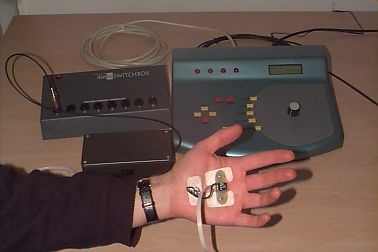
Early prototype of the EMG Muscle
Sensor
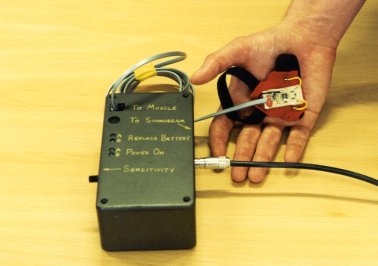
Final Prototype of the EMG Muscle
Sensor
including modular design, electrical isolation,
power level sensing and sensitivity control
(with a special fabric design for wearing in the palm)
* The video segments on this page require the RealPlayer G2 (or better) plugin to be installed. If you do not have this, a basic player can be downloaded free from www.real.com.